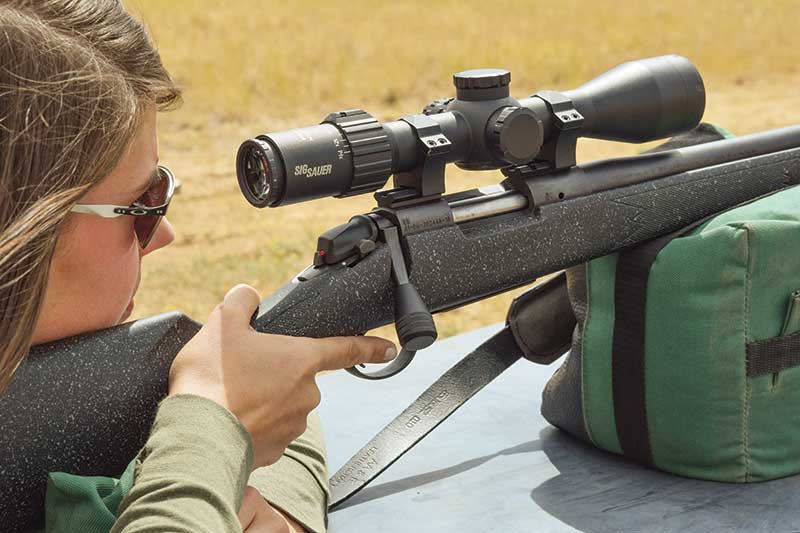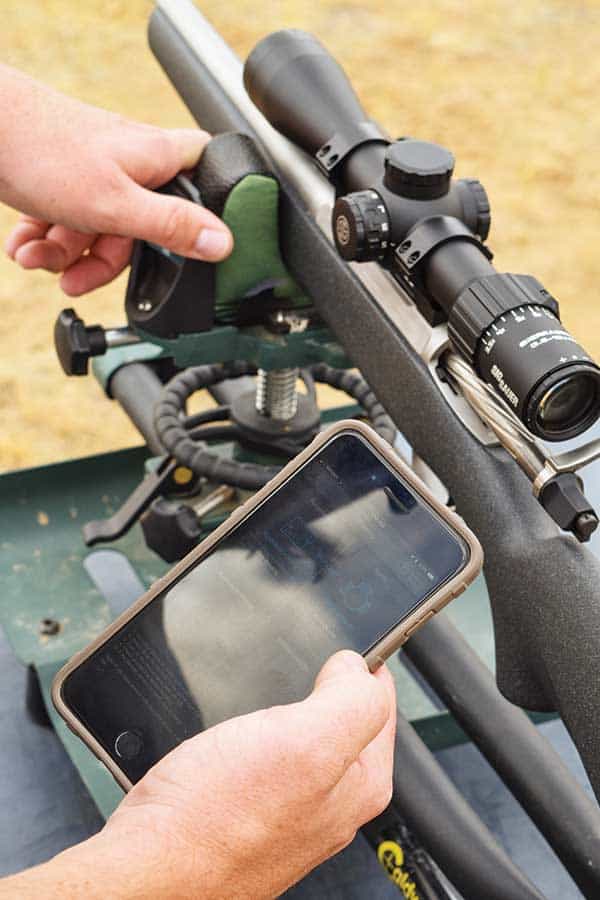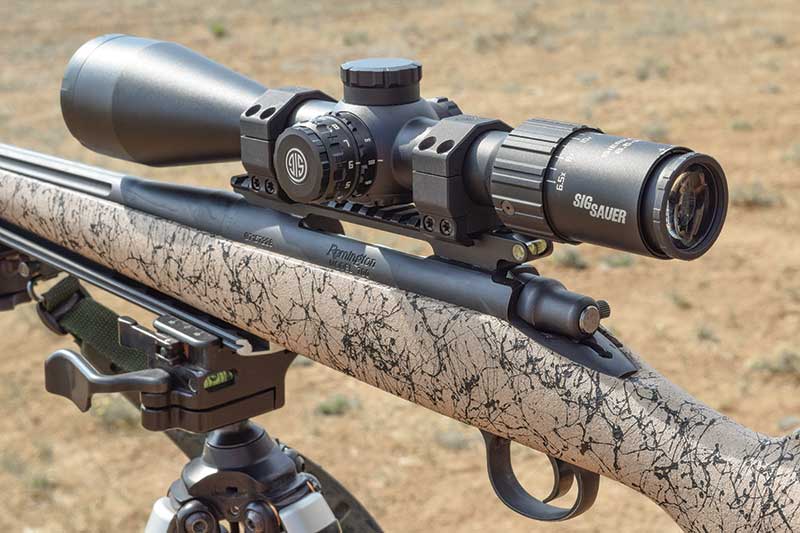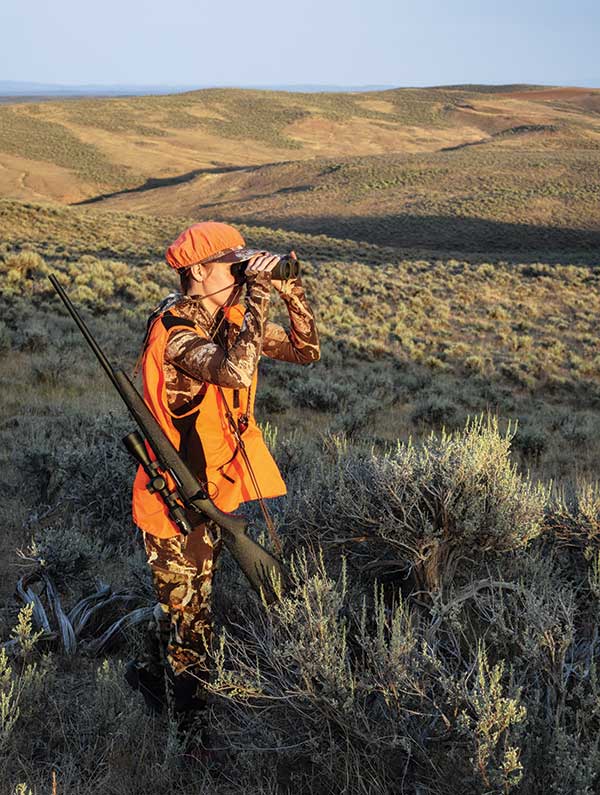SIG BDX
A system for success
You’ve had days that profited nothing. This one was casting long shadows behind the hills north of Craig. Then — “There!” Cory and I pointed in sync. The buck rocketed over the ridge in the dusty wake of a dozen does. Christina caught up as we scurried, bent low, along the lee side. I slipped ahead and went to my belly, wriggling through cactus toward a hump falling off into a deep draw. The herd was looking my way when I peeked over, a doe blocking the buck.
“Got the range,” came a whisper. Gamely, Christina had endured the cactus too. The does sifted away, egg-walking. Years hunting pronghorn told me this buck would dash off without pause. A dot lit up in my scope as his chest came clear. The 6.5 Creedmoor bounced; the buck fell dead.
It would be the first of eight Colorado pronghorns taken in a short hunt with RTS Outfitting — and an ingenious SIG riflescope.
Looks Are Deceiving
“You can’t know what it does by looking at it,” said product manager Joe Fruechtel. Explaining nuclear fusion to a beagle might have been easier but he and Christina Rhine patiently led me through a primer on her 3.5-10×42 BDX. If you’re smart-phone friendly, you’ll catch on in a snap. If, like me, you’re still sweet on Depression-era Hensoldts, the magic in this tube will truly astound.
“It starts with SIG’s BDX app,” Joe explained. “Android or iOS. Downloaded in your phone, it lets you configure your load’s ballistic data and pair — think synchronize — your phone with one of SIG’s BDX Kilo laser rangefinders.” Use factory data or the bullet specs with your own chronograph readings. Following simple protocols, he said, you then “bond” the rangefinder with your BDX rifle-scope, which lets you know when it’s comfy with the union by flashing a blue OLED (organic light-emitting diode). At this point, “the scope is slave to the rangefinder. Range a target and a red dot appears on the scope reticle. Put the dot where you want to hit and that’s where the bullet will land. Simple.”
More like voodoo, thought I. But we hied off to the range with Christina’s Bergara for a hands-on tutorial. “A BDX rangefinder can bond to only one scope at a time,” she said. “But one scope can bond to multiple rangefinders.” Maximum range for a ballistics solution is 800 yards, although BDX rangefinders deliver reads beyond that. I figured 800 was far enough.
Unlike big, heavy laser-ranging scopes with all functions in the tube, SIGs have traditional lines. The four 30mm BDX scopes have brilliant optics, rear-plane reticles and they’re reasonably priced ($600 to $960). All but the 3.5-10x model feature a focus/parallax dial.
Lead Meets Steel
After checking the 100-yard zero of the 6.5 Creedmoor, I swung to a 300-yard plate. Christina read it with her rangefinder. Voila! A red dot appeared on the plex reticle’s lower stem. I steadied it and pressed the trigger. Dust sprayed as bullet met steel, followed by a Whap! “Let’s back up to 430,” said Joe, clearly bored with the predictable. There I went prone, sling taut. The 10×10 plate was now tiny. Christina ranged the steel; another dot lit up. My pulse bounced the first shot a tad high; the follow-up connected solidly.
“What about wind?” I asked, having shaded left in a freshening breeze.
“No instrument can read wind downrange,” said Joe. “But if you have a read on prevailing wind at the line — say, with a Kestrel — you can plug that into the app and the rangefinder tells your scope. A dot off the main reticle stem then appears.” There are 18 “addressable” wind hold indicators in a BDX scope field and 78 vertical hold points.
I noticed two dots on either end of the horizontal wire. “Those are Level Plex indicators, to help you avoid canting,” Joe told me. “You can switch them off or boost their sensitivity — from a 3-degree cant to 2-, 1- and ½-minute for greater precision at distance.” He demonstrated a routine checking the illumination of all dots in a few seconds. “But these aren’t like Christmas tree lights; you won’t get any tired bulbs!”
BDX reticles have 10 brightness settings and “off” stops between, so you’re just a click from the setting you want. Powered by two CR2032 batteries, scope illumination automatically shuts down after a period of inactivity to conserve power. Movement wakes it up.
But what about …
“Yes, the rangefinders are special,” Joe said, anticipating my next question. “There are four BDX Kilo models with Bluetooth chip extensions up front. They range in price from $300 to $960.” I looked them up, there are four. “You can use the 2400 7×25 with an Applied Ballistics program in your Kestrel to engineer hits beyond 800 yards,” Joe added. “Applied Ballistics now has SIG ammunition in its suite of factory loads.” SIG lists three BDX “Combo Kits” with a scope and a Kilo rangefinder, from $840 to $1,680.
BDX rifle-scopes boast 50 to 60 minutes of elevation adjustments in quarter-minute clicks. But once you’re zeroed, you won’t need to dial as the rangefinder does the work. You can specify rangefinder reads in minutes, mils and centimeters and, of course, use the scope without rangefinder assist, for quick shots in cover or point-blank range. The reticle appears clean, as if there were no OLED dots in the field.
Besides keeping a lid on scope weight and bulk, said Joe, “separation of rangefinding and aiming processes enabled SIG to sell the scopes at competitive prices. The system is also more flexible than what you get with single-unit alternatives.” Because there’s no laser in the rifle-scope, SIG’s new BDX system is legal for hunting in all 50 states.
In The Field
The final day of our hunt, Christina Rhine got her chance with the BDX. Hours of glassing had drawn us on sneaks within rifle range of several bucks. Cory shook his head every time. “We can do better.” But as the day spooled out, it seemed big, mature pronghorns had abandoned the prairie between Maybell and Craig. Then, as light dimmed, we hit paydirt.
A bachelor group of a dozen fine bucks fed across a distant slope. Quickly we reeled in a quarter mile, across a basin affording scant cover. Christina wisely declined a poke at 440 yards. We slipped into a valley and swung wide to intercept the herd, now ascending a steep draw. “Left! Left!” I cried. Despite our caution, we’d stumbled into their midst! They swept by us, down into a valley, across our front. “Get set. They’ll stop.” I was talking to myself as Cory hustled Christina into position. She steadied the rifle on a rest and immediately read the range. Beyond 350, I guessed. Her scope “knew” the yard, and a dot on the BDX reticle lit up. When she fired, a beautiful buck collapsed, its horns the biggest taken on the thousands of RTS acres that week. Her first pronghorn!
My next look at game through a BDX scope came at around 200 yards. With no time or need to range it, I aimed and fired as instinctively as with any other sight, no illumination except the Level Plex dots inconspicuous on the field rim. The buck fell dead.
Among the most appealing features of BDX scopes are their traditional profiles. They sit as low as other variables with same-size objectives. Inside, a clean field of view yields sharp, brilliant, color-true images. No matter the distance, you’re ready for the shot and your rifle handles as nimbly as with scopes that don’t talk to rangefinders!
If you don’t remember Depression-era Hensoldts, that’s okay. SIG’s new BDX scopes are better.










